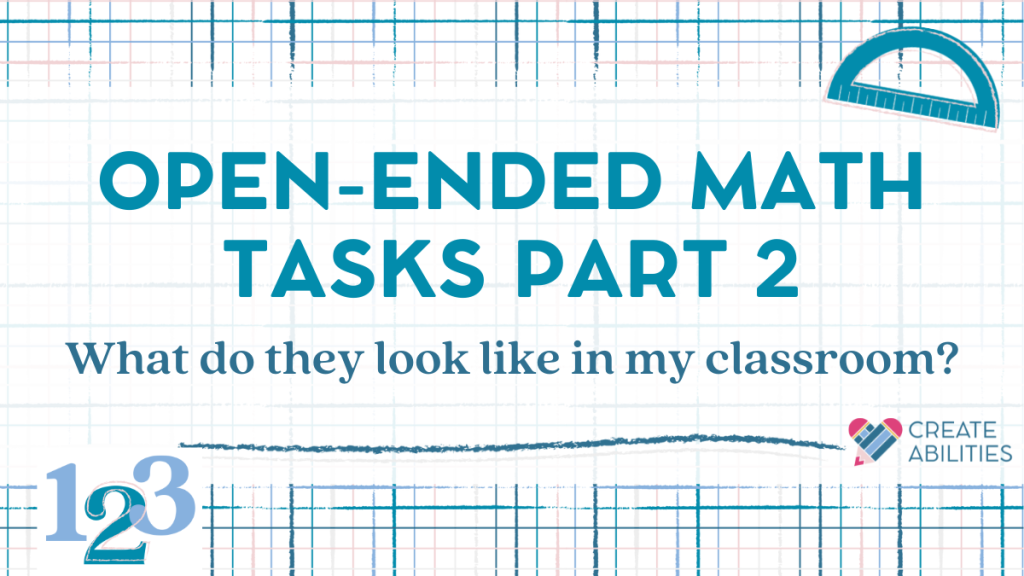
Open-Ended Math Tasks Part Two: What Do They Look Like in My Classroom?
By now, hopefully you have gotten more comfortable with Open-Ended Math Tasks (if you are not sure what I’m talking about, check out this post first). As I admitted, it took me some time to come around to the idea that problems with no set correct answer could be useful in my classroom. Once I dove a little deeper, I realized having so many points of entry was the beauty of these tasks and that they were a natural complement to my traditional math program.
My favorite part of using open-ended math tasks is that it shifts the focus from merely finding the right answer to celebrating the attempt. This is hugely important for both our stronger math students and those who may be struggling. This shift, however, can take some work from both you and your students.
As teachers, we know there are some tried and true steps to implementing any new activity. You will see many of these steps combined with some tips that are specific to these tasks.
Lesson Format
“Cathy’s class went to the farm. They saw cows, horses, and goats. How many of each animal did they see?”
This was the first open-ended math task I tried to have my first graders solve independently. We had practiced a few together, and I really felt they were ready to go. However, when I saw lots of frustrated faces and noticed a couple of my most motivated students simply sitting and looking at the problem, I realized I needed to lay more groundwork to create an environment that was conducive to this new approach to math.
Most of our students are used to the one question, one answer approach. Working through these problems with so many unknowns can be stressful for students at first, so it is important to create some stability by having set routines in place. After some research and reflection, I ultimately settled on the following format in my classroom. Your routine may vary slightly, but these steps can help point you in the right direction
Before:
- Activate Prior Knowledge and Check for Understanding: I like to help activate prior knowledge by reading the task together, and starting an informal discussion. Listening to my students’ thoughts and ideas allows me to clear up any confusion about the actual task, and helps me to ensure they have the appropriate background knowledge.
Using the example from above, you can start by encouraging students to share a bit about their experiences with farms. Now, this can quickly get way off track (unless you want 20 stories about different trips to farms), so you will probably also need to use some leading questions to keep it math based. You want them to think about what number of cows, goats, and horses would be realistic to have on a farm, so ask some questions about this. One thing to avoid, however, is giving them a range of “reasonable” numbers. It’s tempting to do this, but it kind of undermines the whole purpose of these types of math tasks.
I have found students pick numbers they are comfortable working with, so let them that flexibility. Remember-If you do have a student working with numbers that you worry are too large, remember they are not locked in! They can revise these numbers later on in the process. Right now, your job is simply to make sure they have the necessary background knowledge and that they understand the problem itself.
- Talk About Different Strategies: As part of that initial discussion, you can naturally begin to ask guiding questions to help them select strategies. The trick again is to give guidance without indicating a preferred approach.
With the farm example, you might ask how the students plan on keeping track of the animals. Some may choose manipulatives, others might draw them, and some students might simply use numbers. Just getting them thinking of a strategy is key, but hearing that there are multiple approaches often helps build their confidence to try the task. This conversation also provides reassurance down the line that there are other options if theirs doesn’t work out.
- Form Groups and Provide Materials: I have decided it is better to break students into groups AFTER our conversation. They are less preoccupied with their new partners, and can fully focus on the task that way. So, after we have had that class-wide discussion, I assign groups and set out any manipulatives that I think might be useful.
Determining your groups is up to you, but I do have some ideas in Part 3 here. As for manipulatives, I like to keep some predetermined tools ready for my students but allow them to use anything in the room. For this problem, I might set out some linking cubes, colored tiles, and crayons. I will quickly show the class what I have chosen, but remind them they can use anything from the math shelf if they think it is useful. This reinforces that idea that there are multiple approaches, and gives freedom to any students who may have a preferred tool.
During:
Once students have the tools they need, it is time to let them work in the way that they see most appropriate. However, that does not mean there are no guidelines for this time. In fact, there are expectations for both the students and the teachers during this time.
Students’ Role: Open-ended math tasks are designed to facilitate conversation and collaboration between students. They will be working together and sharing their work with the class. For this reason, we need to teach students how to listen to, support, and validate each other’s ideas. Students need to know that they can question another student’s idea, but that they may not do so in a disrespectful or offensive way. Therefore, you may need to spend some time teaching your students the words to use in these situations, and modeling productive math conversations.
Once your students know how to work together and encourage each other, they will begin to feel safer taking risks. This is another important part of their role! Students are expected to try new approaches until they find one that works, and to never give up! By having these expectations for your students in a safe and supportive environment, they will be maximizing the benefit of open-ended math tasks!
- Teacher’s Role: While your students are engaged in meaningful dialogue and working together on these problems, it is imperative that you are constantly moving about the room checking on their progress. If your students can see you are readily available if they need you, they will be more comfortable taking those risks we want! Observe what they are doing, and listen to their math talk. In addition to being ready to assist when needed, you will gain valuable insight into their math abilities.
If a group does need help, be careful to guide them without giving them answers. This was tough for me at first, I have to admit. I had to learn to ask guiding questions and to point out possible errors in thinking without giving a suggestion of how to fix it. This is harder than it sounds, but super important!
It can help to communicate the expectations for both teacher and students to the whole class (and any other adults also may be in the room at that time). This cuts down on their frustration with me for not giving them the answers, and also can allow them to keep working instead of checking in with me. Clearly communicated expectations are always helpful, and this situation is no exception!
After (Sharing):
The last 5-15 minutes of this block should be spent allowing students to share their ideas and work. I was guilty of skipping this early on when I couldn’t seem to fit everything in, but I have come to realize that sharing is a critical component of math tasks! Now, I am sure to select different students to share each week. I just have them display their work using the document camera. They then simply explain their approach and strategies to the class. The benefits of this are two-fold: the other students see a potentially different strategy to solve the same problem, and the sharing student(s) build confidence as they get to be celebrated for their work!
Sharing can feel awkward at first, so here are some tips for making it a little more natural and maximizing its effectiveness!
- Clarify shared ideas: We often need to ask some clarifying questions as young students get comfortable talking about their math thinking. You can ask, “What would you do differently next time?”, or “Which strategy made sense to you and why?”. After they have shared, it is also great to restate what the child said (or meant to say). This helps reinforce what the students have said, and also validates their work!
- Emphasize reasoning: Building math reasoning is a major goal of using these types of tasks, so we want to give our students a chance to really show how they are thinking. You can ask questions like, “Explain how you know your answer is correct”, or “Why does it make sense to start with that number?”. Try to remember to ask these types of questions on both correct and incorrect work so students don’t get nervous when asked to explain, or feel like you are targeting them.
- Encourage student-to-student discussions: It’s very powerful for students to talk to each other about their work. You can enable these conversations by asking them to turn and talk with a seatmate about why they agree with the presenting student(s)’ work, or asking them to tell a partner something they did that was similar to the presenter. This also ensures that all students are actively involved during this time, instead of just the student doing the sharing.
This is the format my lessons take when using open-ended math tasks, and there are hopefully parts that will work for you as well. Obviously, every classroom is different. It is important to do what feels natural for you, and to make these tasks work for your students. However, it is also critical to have set procedures in place and to communicate them clearly to your students. By doing this, you allow your students to focus fully on their work and to feel comfortable taking risks in their work. Once you create that safe and supportive environment, you will see the maximum benefits of open-ended math tasks.
If you are ready to begin, you might want to check out the Create-abilities Open-Ended Math Tasks Webinar that has a wealth of information and an eBook full of resources. You can also check out the next blog post in this series to learn about how to group students, create tasks, and grade work when using open-ended math tasks.
How do you communicate expectations to your students during open-ended math tasks?
Blog Categories
Meet the author



